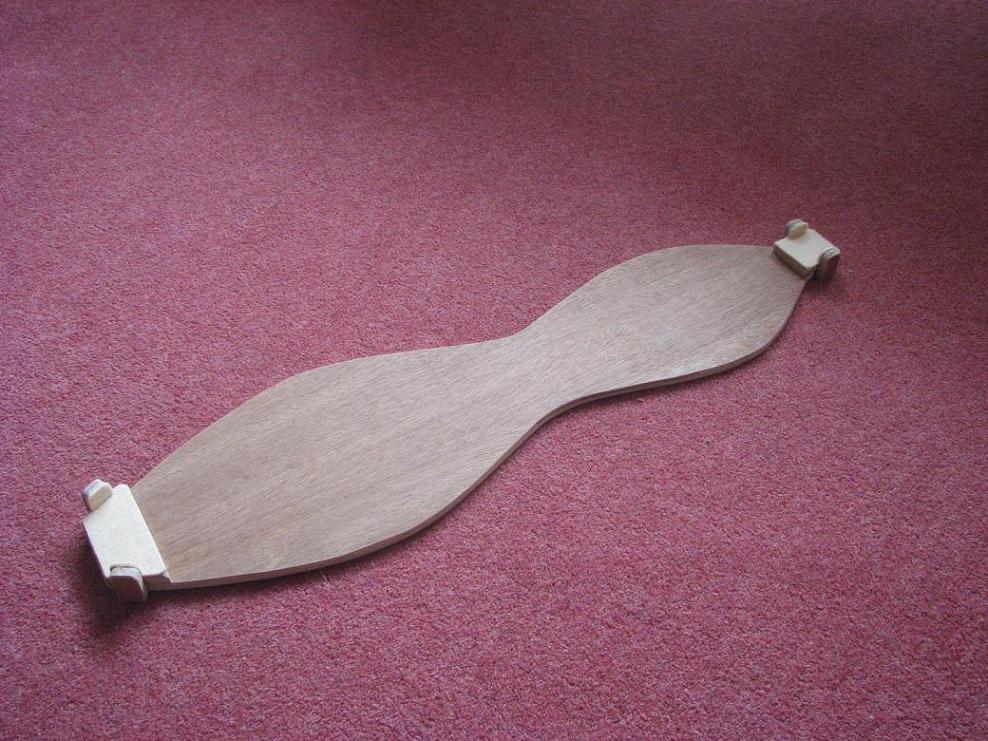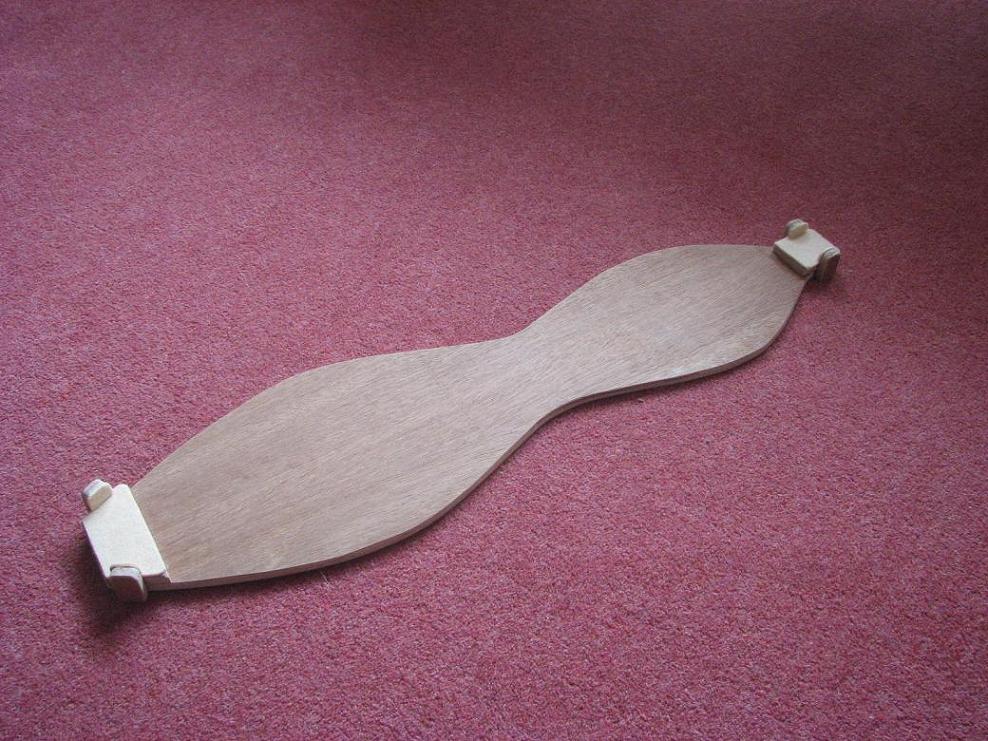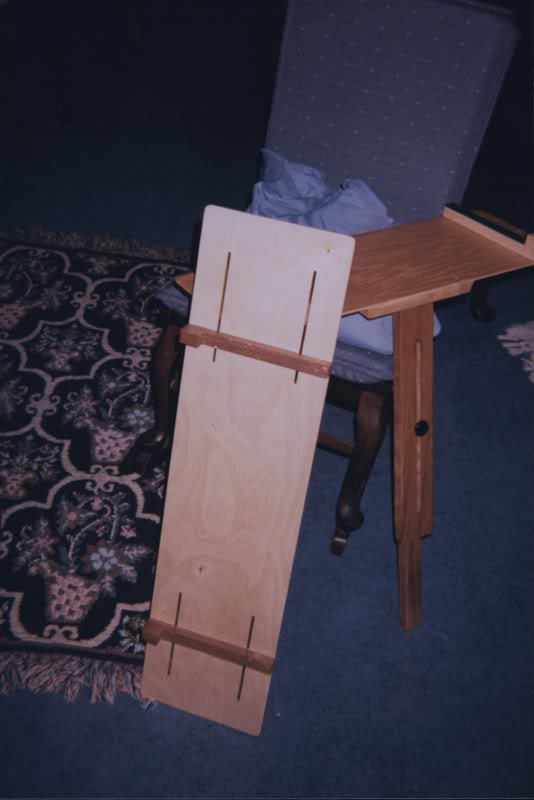Here are some photos of the board. I simply cut it from a piece of ply. It really only took me an hour or so to build. I didn't put much time into it as I wasn't sure if it would work - but I've been using it every day for the last 9 months!
purpose of design features on a MD
Here are some photos of the board. I simply cut it from a piece of ply. It really only took me an hour or so to build. I didn't put much time into it as I wasn't sure if it would work - but I've been using it every day for the last 9 months!
Here are some photos of the board. I simply cut it from a piece of ply. It really only took me an hour or so to build. I didn't put much time into it as I wasn't sure if it would work - but I've been using it every day for the last 9 months!


Robin
Dusty Turtle said:
D.T.
Robin Clark said:
Robin
--
Dusty T., Northern California
Site Moderator
As a musician, you have to keep one foot back in the past and one foot forward into the future.
-- Dizzy Gillespie

D.T.
Robin Clark said:
Robin
Robin
--
Dusty T., Northern California
Site Moderator
As a musician, you have to keep one foot back in the past and one foot forward into the future.
-- Dizzy Gillespie
Tail-end lifting when you fret near the head is caused by not having your knees far enough apart and the dulcimer placed incorrectly on your lap. The nut or first fret should be over your left knee, the other end tucked into you right hip. The dulcimer does not naturally sit at right angles to your lap.
Personally I find straps very encumbering and restricting.
--
Dusty T., Northern California
Site Moderator
As a musician, you have to keep one foot back in the past and one foot forward into the future.
-- Dizzy Gillespie

The zero fret is a manufacturing shortcut, for the most part. To adjust the string height at the nut takes longer, so some makers use a zero fret. I don't mean to imply that it is to be avoided. If the maker uses it, that's fine. What I meant to express was that it was no particular advantage for the player, and not worth adding as an option at extra cost. Frequently, manufacturers ship their instruments with high action, allowing the dealer to adjust it to the preferences of the buyer. I have seen a lot of guitars and other instruments on which the dealer didn't bother to adjust the string height at the nut, leaving the purchaser with an instrument that was hard to play. Some don't have personnel to make these adjustments, and tell you to take it somewhere at your expense.These dealers should be avoided. I shouldn't have said "maker" in my original post, as the problem mostly rests with dealers who don't build instruments. A lot of good dealers are out there, ready to adjust any instrument they sell. I hope I haven't created confusion. One of my dulcimers has a zero fret, but whether there is a sound difference from that, I couldn't possibly say. There are too many differences in my 2 dulcimers to narrow it down to any one factor.Paul
The advantage I see in the possum board over a double back is that with one possum board all my dulcimers can have a freed up bottom for an increase in volume, or not if I don't want or need the extra sound. Just a thought.

--
Dusty T., Northern California
Site Moderator
As a musician, you have to keep one foot back in the past and one foot forward into the future.
-- Dizzy Gillespie

And I think a well made instrument shouldn't need a zero fret to improve intonation.
--
Dusty T., Northern California
Site Moderator
As a musician, you have to keep one foot back in the past and one foot forward into the future.
-- Dizzy Gillespie

 And I think a well made instrument shouldn't need a zero fret to improve intonation.
And I think a well made instrument shouldn't need a zero fret to improve intonation.
--
Site Owner
Those irritated by grain of sand best avoid beach.
-Strumelia proverb c.1990
I play noter and drone on unison strings though so having a different timbre on two of my strings is a noticeable problem. I suspect if I was a chord style player then I might not notice it as much because the members of the chord would be fretted more often.
I do play Galax style (but don't own a Galax instrument, yet) and the double bottom is traditional in that style. As I understand, the only real purpose is to remove the dampening effect our lap has on the back just as playing atop a resonator box (or table) would. What I wonder though is why, if we're interested in transferring vibration to the back, that we don't use a soundpost in conjunction with that false bottom.
--
Dusty T., Northern California
Site Moderator
As a musician, you have to keep one foot back in the past and one foot forward into the future.
-- Dizzy Gillespie
Binding is said to protect the corner/joint from damage coming from minor impacts, besides its cosmetic function. It is the one "option" that the guy who built my dulcimer really pushed, for that reason.
Scalloped fretboards look really cool when done correctly. That is almost enough to justify them by itself.
I wouldn't rule out a builder just because they do or don't use a zero fret, it is just a differnt way of doing the same thing. I certainly wouldn't ask a luthier to add one if they don't usually use it, or delete one if they do. There are fine instruments around built both ways.
Even if there ae no luthiers at a festival, there are usually people there with a number of different dulcimers that you can see, hear, and often play if you ask nice.
Good luck!
--
Dusty T., Northern California
Site Moderator
As a musician, you have to keep one foot back in the past and one foot forward into the future.
-- Dizzy Gillespie
Other builders will be more adaptable as to size, depth of body, woods, sound holes designs etc. Talk to them about your wants as a buyer. Let them play a few instruments from what they have in stock and see if you and the builder can come up with a mutual design.
Dusty Turtle said:
It's apparent that there are a lot of variables involved, which makes me even more nervous about buying an instrument from someone whose work I've never played or heard.
D.T.
folkfan said:
--
Dusty T., Northern California
Site Moderator
As a musician, you have to keep one foot back in the past and one foot forward into the future.
-- Dizzy Gillespie
It's apparent that there are a lot of variables involved, which makes me even more nervous about buying an instrument from someone whose work I've never played or heard.
D.T.
folkfan said:
--
Dusty T., Northern California
Site Moderator
As a musician, you have to keep one foot back in the past and one foot forward into the future.
-- Dizzy Gillespie
Many makers allow the top to move more freely by decreasing the fretboard internally. They rout it out. Others will scallop. I like the full length fretboard for the bracing of the top along the complete length of the fretboard. Personal preference.
I've never had a dulcimer with a binding so I can't tell you anything about them.
Personally I like a semi gloss finish in a lacquer. The really heavy glossy coating on an instrument as small bodied as a normal dulcimer would deaden the sound, (IMO)
For my hand size I prefer a VSL just under 26inches, I had one once with a 30 inch and never could play it. I tried to learn chording on a longer VSL, but had an increased problem with my hands due to the stretch and strain, so gave up chording entirely.
I'd say go with the 1+ and 8+ if you think you'll use them.
--
Dusty T., Northern California
Site Moderator
As a musician, you have to keep one foot back in the past and one foot forward into the future.
-- Dizzy Gillespie
The zero fret is just in front of the nut. It allows the strings to be as close to the neck at the 1st fret as it would be to other frets when you press the string down to the frets. A skilled maker can adjust the nut height so the zero fret is unnecessary, but some makers use them. I have one guitar & one dulcimer with zero frets, and others without. I wouldn't order one on purpose, if your chosen maker doesn't normally use one. It does nothing to justify the expense, unless the maker doesn't want to take the time to adjust the string height at the nut. If a builder told me he wasn't willing to make his instruments play well, I'd find another maker. On the other hand, my dulcimers were both kits. The maker of a kit has no control over the abilities, or lack of abillities, his kit will recieve. I can completely understand the use of a zero fret in a kit. It's much simpler for a hack like me to get good action without ruining 2 or 3 nuts on the way. It also makes it possible to build a kit with less nut slotting tools. Again, the home hobbyist/builder is in mind here.
Binding is mostly decorative. It does seal the end grain of the wood, but I'm not sure how much need there is for it. Mine don't have it, I suspect most kit models don't.
A thick heavy finish will deaden the sound of an instrument. But a proper, thin finish can shine, it depends on the product used.
A short VSL will bring the frets closer together. If you have small hands, this makes it easier to play, if you use chords, or find yourself stretching to get your thumb on a fret far above your fingers. Playing noter style you might never see a problem either way. With a longer vsl, you have to tighten the strings to a higher tension to reach the same pitches. This extra tension makes the strings a bit harder to press to the frets, but with the action adjusted correctly, this shouldn't be a problem/ That goes back to the nut adjustment in the 1st question, plus the bridge height.
Softer woods such as spruce and cedar are pretty much the standard for most string instrument tops, with hard woods the standard for back & sides. The best thing to do is play as many dulcimers as you can to hear how the different choices affect the sound. Maple is a brighter sounding wood than walnut, mahogany or rosewood. It really comes down to what you want your new toy to sound like. Try as many as you can, and see what you like in woods, sounds and VSL's. Take your time, there's lots of choices. You wouldn't want to miss any!
Paul
--
Dusty T., Northern California
Site Moderator
As a musician, you have to keep one foot back in the past and one foot forward into the future.
-- Dizzy Gillespie
Howdy folks. The one-year anniversary of the purchase of my first and only dulcimer is fast approaching, and since it appears the dulcimer is going to "stick" with me, I am already considering a second dulcimer. There are so many decent builders out there it is intimidating, but there are also a variety of design features the purpose of which is not clear to me. Please help.
a double back : My understanding is that the false or double back just lifts the "real" back off your lap so that it can vibrate better and provide more volume. Is that correct? I play with a strap around my lower back and the dulcimer tilted up slightly, not vertical like a guitar, but not fully horizontal either. So when I play the bottom is raised partly anyway. With that physical approach, would a double back accomplish anything?
a scalloped fretboard : I may be using this term incorrectly. On a guitar, a scalloped fretboard is one in which the fretboard in between each fret is scooped out so that you finger the string but don't actually press it against the wood. But I think the term is used with dulcimers to refer to a style of attaching the fretboard to the soundboard not continuously, but at regular intervals like a series of arch bridges, so that the fretboard sits above the soundboard, as in this Nicolas Hambas Concert Grand: http://www.hambasdulcimers.com/MOUNTAIN.html . What is the purpose of that feature? Does it allow more vibration of the soundboard? Does it allow sound to come out from under the fretboard? I think I saw one dulcimer that had no visible soundholes, for the holes were "hidden" underneath the scalopped fretboard. What exactly is the purpose of a scalopped fretboard?
a zero fret : I may not have sufficient understanding of physics, or maybe myears just aren'tthat discriminating, but what exactly is the purpose of the zero fret? I think I read somewhere that a zero fret allows more precise intonation than using the nut. I don't understand why that would be the case, but is that correct?
binding : most guitars have some kind of binding along the edges of the instrument, but few dulcimers do. Is this merely cosmetic? I can't think of any potential effect on the sound, but a couple of luthiers offer binding as an option.
finish : some luthiers use a lot of lacquer and create a really shiny finish. My current dulcimer was not treated in such a way. As a result, it probably gets dirtier faster, but I would think that lacquer would restrict the vibration of the wood, so you would get a clearer and maybe louder sound if the dulcimer did not have a lacquer finish. Am I on the right track?
VSL : I've heard people with small hands request shorter VSL. But what are the advantages of a longer VSL? Does a longer VSL increase the playability (is that a word?) higher up the fretboard?
Finally, this is where I think I am headed with my next dulcimer. Please scream and yell if my choices seem ridiculous. I expect to get a dulcimer with a softwood top (western red cedar or sitka spruce) and a hardwood everything else (perhaps quilted maple because I like the look). It will be a six-string with the octave on the bass string. I am hoping to get a fuller sound out of my dulcimer and think the double strings will help. And I expect to add the 1+ and 8+ frets. I can see no reason save for tradition's sake not to add those extra frets. I play chord/melody style so I don't have to worry about sliding my noter over those extra frets.
I understand we all have personal tastes, but I just want to make sure I am not going to order some kind of disaster instrument that I'll never play. And there are other variables (tuners, for example) that I haven't mentioned. If you think of any other important variables I should be considering, let me know.
Much thanks in advance.
D.T.
--
Dusty T., Northern California
Site Moderator
As a musician, you have to keep one foot back in the past and one foot forward into the future.
-- Dizzy Gillespie
updated by @dusty: 07/31/23 10:38:16PM
